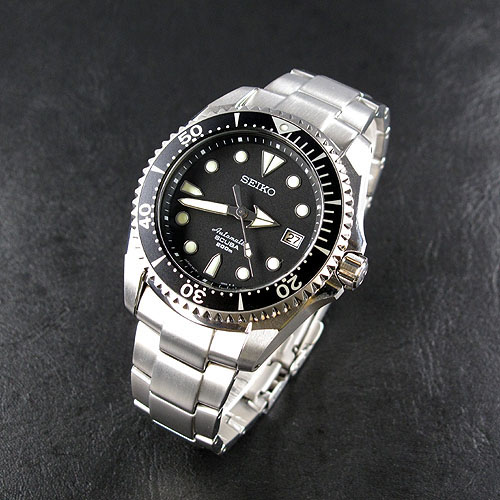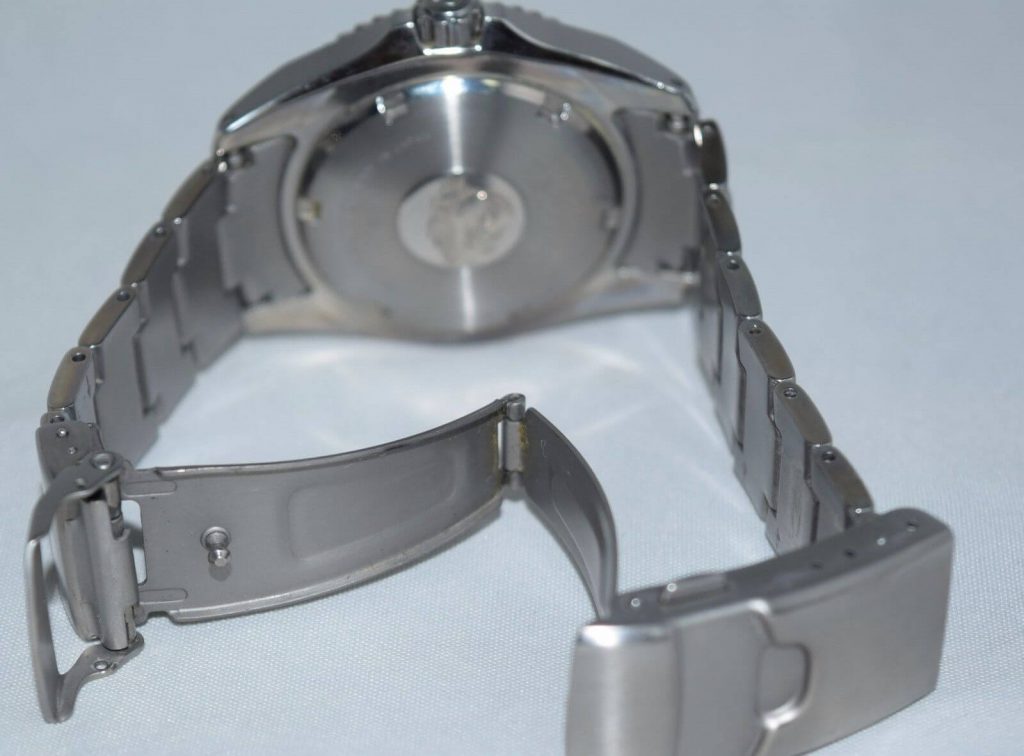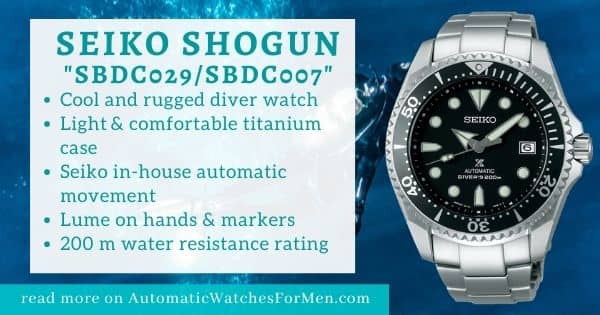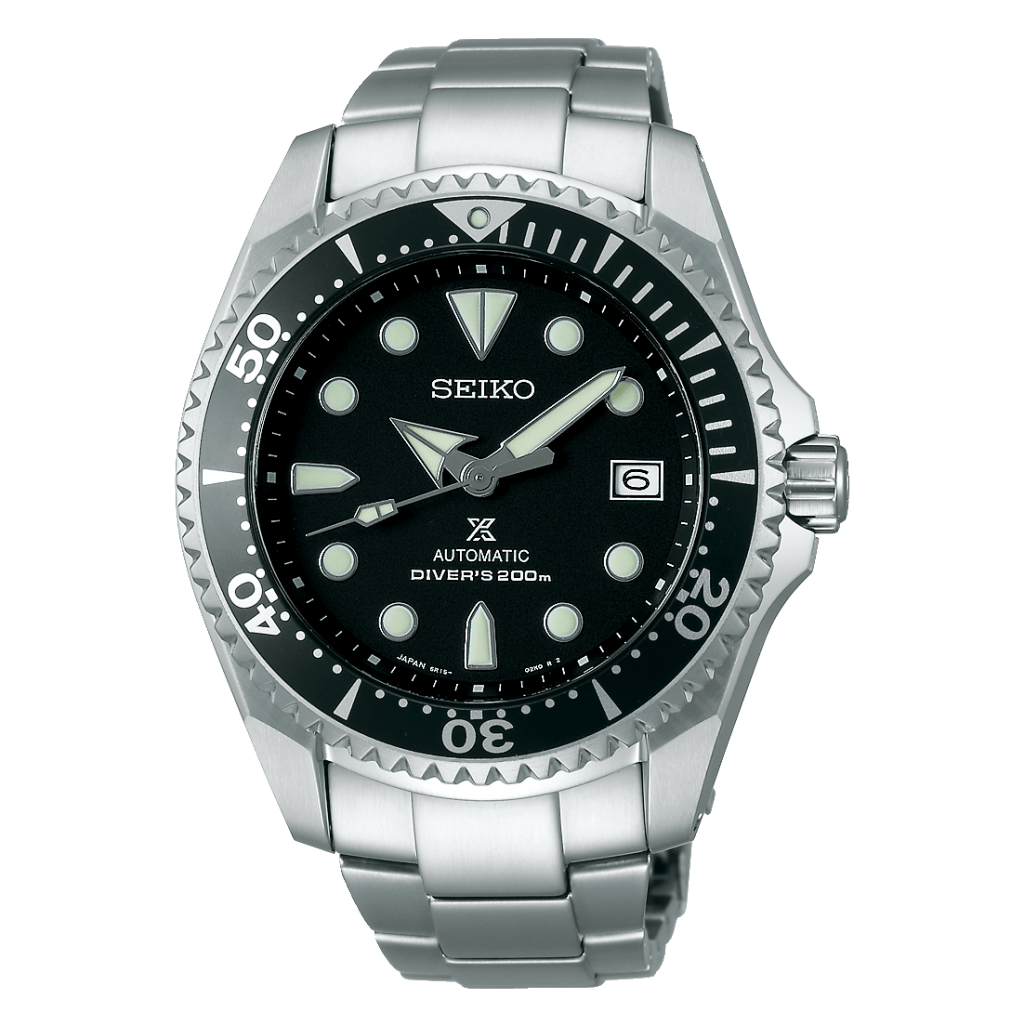The Seiko SBDC029 (or its previous version SBDC007) is one of the popular Seiko automatic dive watches among Seiko fans. It does have a cool nickname “Shogun” that definitely will pique any Seiko fans interest. So what is the Seiko Shogun all about?
In my opinion, the Seiko Shogun is a great looking design diver watch that has such a cool design with its sharp and clean cuts. It also has the much desired titanium case making it lightweight and definitely help to make the watch wearable and much cooler to any fan.
However, the titanium case do make the Shogun pricier than a typical Seiko automatic watch. Thus, in this post, I’m going to write about the Seiko Shogun review so that you’ll know what the watch is all about, its detail specification and whether it’s the right one for you (or you’re better off with a cheaper watch… I’ll save that later).
Why The Shogun Nickname?
First and foremost, I’m sure you are wondering why is the watch called “Shogun”? The Shogun is actually a nickname given by Seiko fans on the WUS site to the watch and not the official name by Seiko (unlike the Alpinist models).
Based on the originator, it was named as such because of the full armor, crisp lines and it’s always under attack on the forum (due to many reasons, of which I’ll deliberate further below).
What do you think about it? If you have other thoughts on the nickname, share it by commenting on the post below =)
| Seiko Shogun Watch Specification (SBDC029) | |
|---|---|
| Diameter | 44 mm |
| Thickness | 13 mm |
| Lug Width | 22 mm |
| Case | Lightweight Titanium Case (114 g with bracelet) |
| Strap | Oyster titanium bracelet with double lock clasp and dive extension |
| Watch Crystal | Hardlex crystal |
| Dial | Black analog dial |
| Hands | Arrow hands |
| Markers | Index markers |
| Style | Dive |
| Movement | Seiko Caliber 6R15 Automatic self-wind movement |
| Movement Features | Seiko In-house movement, 23 Jewels, 21600 vibrations per hour or 6 beats per second, Hacking, Manual winding |
| Accuracy | +25/-15 seconds per day |
| Power Reserve | 50 hours |
| Water Resistance | 200 m |
| Other Features | Unidirectional rotating bezel, Screw down caseback and crown, Lightweight titanium case, Anti-magnetic case, Seiko’s LumiBrite lume, Date display, ISO 6425 Diver’s Watch Compliant |
| Best Place To Buy | Amazon (Where most of the time the Shogun is listed for less than $1,000), The actual MSRP for the watch is $1,200 on Seiko USA website |
Seiko SBDC029 VS SBDC007
Just like the Sumo, the Shogun also has 2 different model numbers with the first one was the SBDC007 release 5 or 6 years ago.
It was then replaced by the SBDC029 with the “X” logo on the dial as part of a widespread exercise by the brand to clearly identify the watch as part of the Prospex line up. Prospex or “Professional Specification” is Seiko’s line of watches designed for extreme use, be it in water, air or land.
With the newer version, the SBDC007 was discontinued though one might popped up occasionally on internet marketplace.
Above is the current Shogun – the Seiko SBDC029

And above is the older generation of the Shogun – SBDC007. Notice the difference?
The difference between the SBDC029 and SBDC007 is largely on the dial. I kinda like the italicized “Automatic” signature on the SBDC007 and don’t really prefer the “X” on the newer SBDC029.
But then the SBDC029 has the “Diver’s 200m” signature – something that can only be printed on the dial for watches that conform to ISO 6425 diver’s watch specification. Whether Seiko did any changes on the internal movement is unknown.
So which one should you get?
It largely depends on your taste, that’s for sure. Some love the “X” while some loathe it. One thing for sure though – if you want to get the best bang for your buck, the SBDC029 is the better choice.
Because logically, I’d want to buy something that’s made in this year rather than getting a watch that was made a few years ago – assuming you can still find an unused SBDC007. But if you really love the older look of the Shogun, then go for it =)
Very Legible And Sublime Black Dial
Looking on the Shogun, we are welcomed with the black matte dial, with the typical styling of a dive watch.
Some say the black dial is kinda boring, but we need to remember that this is a watch made for those wanting to actually use it under water.
As such, the use of matte dial is very much logical as the watch need to be very legible for it to work efficiently under water.
Helping to achieve that are the oversized hands and markers. If you need a more easy to look at watch, look no further a the Shogun is definitely very easy to tell time with.
The white markers and hands contrasted with the black dial making telling time very easy to do. There’s also the minute markers on the bezel (more on that later) which helped to compensate for the lack of numeral markers.
As always, the hands and markers are filled to the brim with Seiko’s own LumiBrite, their answer to the Swiss’ Superluminova lumes.

Bright glow-in-the-dark lume is one of the best features in a dive watch, and the Shogun does not disappoint
This stuff will glow brightly under the dark, provided it is exposed to sufficient light beforehand. But speaking from experience with my other Seikos, the lume have a hard time to stay glowing for a full movie showing – about 100 minutes or so – but it’s certainly on the upper tier of lume paints.
In addition, there’s the date window at the right hand side of the dial as an added functionality.
The Shogun Should Use More Unique And Beautiful Hands
One thing that’s a bit off with the Shogun is its hands are taken from the Seiko Monster (you can read my review of the Monster here).

Watch above is the Seiko Monster. Notice the similarity of the hands of both watches
As you can see, the minute and hour hands of both watches are basically the same, save for the outline of the hands.
The hour hand is a stout and huge arrow-shaped while the minute hand is wide and sword-shaped. The seconds hand of the Shogun, on the other hand, bears similarity with the seconds hand on the Sumo.
In any likelihood, the usage of the same parts across models from the same brand is usually permitted.
But in the case of the Shogun, this feels kinda off considering the fact that the Shogun has an MSRP price of $1,200 which is at least double than the Sumo and triple than the Monster.
This is one of the source of contention within the watch fans as many believed that Seiko should at least try to make a unique (and more pleasing) hands for the Shogun which is befitting of its commanded price. To use hands similar to a much lesser priced watches in their stable is not a praised-worthy act.
Clean, Striking Gear-Like Bezel
Another element that I like about the Shogun is the aggressive bezel. The gear-like edges of the bezel does not only make the watch looks outstandingly rough, but also helps with the grip.
This is the diver’s watch bezel which can only be rotated in counter-clockwise direction (or unidirectional) to keep help keep track of time.
A gear-like edge will make it very easy to rotate it even if your hand is wet with all the water.
While looking tough, the small fonts and subdued font on the bezel does not make it stand out too much, in contrast to the bezel on the Monster.
The bezel still keeps the sublime look of the Shogun intact. If the Seiko Monster is like a rough, brash and rebelling teenager, the Shogun can be likened to a dangerous mafia – looks all nice and smart on the outside but is someone you’ll never want to mess with =)
Lightweight Titanium Case Giving Comfortable Use
The main feature of the Shogun that makes it well loved by fans (not to mention also bumped its price) is the use of titanium as its case and bracelet material.
As most of you might have known, titanium is a stronger than steel but is much lighter. But one downside is the cost of titanium is more expensive than steel, which is obvious by looking at the price of the Shogun.
In return, we are getting a very light watch at just 114 grams (including bracelet) compared to the usual 200 grams or so for a similarly sized stainless steel watch.
This makes the watch very comfortable to be used despite it’s bigger-than-average size of 44 mm diameter. If you have a problem to use a stainless steel diver’s watch due to its heavy weight, the Shogun might be the answer for that.
Just be warned that your other watches might get lesser wrist time because of the Shogun LOL!

Seiko’s Diashield For Scratch Protection
Pure tTitanium is inherently not as hard as steel i.e it titanium watch will get scratches easier than a stainless steel watch. It’s also duller and lack luster (gray colored) compared to the shiny stainless steel.
Due to this, most manufacturers will coat their titanium watches with a coating to improve its surface hardness (making it more resistant to scratches) and add a bit of life to the watch to make it less dull.
For the Shogun, Seiko had used their proprietary Diashield coating technology on the watch which makes it 2 to 3 times harder than normal stainless steel.
With this coating, the watch body will be protected from scratches even better than a normal stainless steel watch.
But is Diashield enough to avoid scratches on the watch?
Sadly, no. Based on Vickers Hardness (Hv) scale, stainless steel is at ~200 Hv while pure titanium is at ~100 Hv. A greater Hv number means a greater resistance to scratches i.e it’s harder.

As a comparison, sapphire, the best watch crystal that can be scratch free for years of usage is at ~2,300 Hv. The Diashield has a Hv of 400 to 600 – a great improvement over pure titanium and stainless steel but still not up to par with sapphire.
The point here is you still need to take good care of the Shogun even with the Diashield coating on it as it’s still not enough to protect it from harder materials with higher Hv that can still scratch it.
(Read also this great info on the comparison of Seiko’s Diashield, Citizen’s Duratect coating and other materials on SeiyaSeiko website. Apparently Duratect is miles better than Diashield =P )
Cal. 6R15 Automatic Self-Wind Movement
At the heart of the Shogun is Seiko’s own Cal. 6R15 automatic self-wind movement. The automatic movement has 23 jewels and vibrates at 21,600 times per hour – or 6 beats per second.
We can actually tell this by looking at the seconds hand jumping (6 times) swiftly in-between every second.
This is a bit lower than the similarly priced ETAs (2824-2, 2834-2, etc) that have a typical 8 beatings per second which produce a more fluid sweeping seconds hand movement.
In terms of accuracy, the 6R15 has a maximum +25/-15 seconds accuracy per day. So if your watch is gaining or losing time more than this, it’s best to go and bring it to be checked by a service center.
And of course, the automatic movement has hacking and manual winding capabilities. These are sort of standard with any automatic movements right now.
In fact, any new movement that does not has these features can be said inferior. What hacking does is making sure the seconds hand (and the time of the watch) to stop completely when we pull out the crown to adjust the time.
This enables the owner to accurately adjust the time with little deviation.
Manual winding means the ability to recharge the power reserve of the watch by simply rotating (or winding) the crown.
This will directly tighten the mainspring (the spring that holds the power reserve) inside the watch.
What’s good about that is a few rotations (Seiko said about 20 good rotations) is enough to fill the power reserve to full capacity, compared to the many hundred swings of the weighted rotor on its back to do the same.
In practical terms, manual winding is great to jump start the watch from idle and also to keep it running accurately.
(Read more on how automatic watch works from my previous post here)
Meets ISO 6425 Dive Watch Standard – Your Ultimate All-Rounder
One great thing about Seiko’s dive watches are how almost all of them meet ISO 6425 standard for dive watch.
When you see the “Diver’s 200m” on its dial, we can be sure that the watch is sturdily built and meets the numerous specification required as a dive watch.
Even I, who is not a diver, think that such a wathc is a great tool in my collection. My thinking is that if this watch with its great specs that can withstand diving up to 200 m, I’m pretty sure it can withstand whatever I’m throwing at it on.
A round of swimming? Going to the beach? Gym sessions? These are not a real problem for a watch built like a tank such as this.
With its handsome looks and magnificent robustness, the Shogun is a great all-rounder that you can use anywhere, for any occasion.
Of course, a formal event might be a bit too much for this timepiece but I think using it as a work watch at the office is very much acceptable.
On the other hand, a real dress watch is constrained for just formal use and some casual use. In this regard, a dive watch such as the Shogun has a lot of flexibility of use thanks to its versatility.
I found this video on youtube that shows how the Seiko Shogun is still ticking even after being freeze in a fridge! That’s how tough this watch is!
Seiko Shogun vs Sumo : Which One Should You Get?
A very frequent question that is being thrown out is which one is better: Seiko Shogun or Seiko Sumo? (Check out my review of the Sumo here).
This comparison is usually done because these 2 are Seiko’s mid-range priced dive watches. Both are loved enormously by fans, though the Sumo can be said to be more popular due to its cheaper price.
To make a comparison on these 2, I’ll breakdown both watches into a few criteria as below.
(Disclaimer: I’ve owned a Sumo – a Blumo to be exact- for 4 years now but I can assure you my assessment of both watches is impartial)
1- Look And Design
While the Shogun looks like a typical dive watch (a-la Submariner), the Sumo is something of its own.
It’s diagonally placed crown (at 4 o’clock), rounded curved shaped case and huge numerals on the bezel make the Sumo a unique watch with styling not found on any other.
That’s not to say the Shogun does not look nice – Seiko did a great job making the Shogun looks terrific with a normal dive watch look. In my opinion, both are great looking watches and there is no clear winner in this.
At the end of the day, it really depends on the individual himself on which style he wants.
If you’re looking for a good and cheaper alternative to the Submariner, the Shogun is up for the job. But if you want a unique looking dive watch, the Sumo is the one you should consider.
2- Movement
Not much to be said here as both uses the same 6R15 automatic self-wind movement. Read my explanation of the movement at the previous section to learn what it’s capabilites are.
3- Material
In my opinion, this is one of the biggest difference between the two watches. The Sumo uses the normal stainless steel case while the Shogun has the titanium case.
Without any doubt, the Shogun is the clear winner in this. The titanium case with Diashield coating is not only lighter but also more scratch resistant than the stainless steel on the Sumo.
4- Pricing And Value Proposition
Finally, we come to the last criteria. Price of the watch is usually an important, if not, the most important aspect whenever someone is looking for a watch to buy. The MSRP of the Shogun SBDC029 is $1,200 while the Sumo SBDC031 is $600 .
Which means the Shogun is double the price of the Sumo. But things are a bit different in the gray market (Amazon, Ebay, etc.) with both watches can be had for discounts of up to 30% to 40%.
But the trend is still similar: the Shogun is always more expensive than the Sumo.
Now, if you’ve been following my comparison you’ll notice that the difference between these two watches that can make the Shogun more expensive is only on the material used.
Granted, titanium is more expensive than stainless steel. It’s easy on the wrist, very comfortable and thanks to the Diashield, it won’t scratch easily. But does it warrants the Shogun to be double the price of the Sumo?
If you want a lightweight and comfortable watch to wear, you might be OK with forking out the money for the Shogun.
But if you don’t think it’s wise to pay double for an comparable watch (both watches do have the exact same movement btw) and don’t mind the extra weight, you might want to go for the Sumo instead.
In the end, this is the question that only you yourselves can answer =)
Check out this video on the comparison of the Seiko Shogun with the Sumo and Monster.
Who Is The Shogun For?
In my opinion, the strongest selling point of the Shogun is the lightweight titanium case which will make wearing it a very unbelievable experience.
If you can’t use normal stainless steel watch because of its weight, then the Shogun is the right watch for you.
Because of the titanium, it’s much lighter than what it looks like, and I can tell you a 44 mm diameter normal stainless steel dive watch is not light at all.
In addition, it’s classic dive watch look with modern styling is handsome and something that I’d love to see on my wrist everyday.
So if comfort, a handsome and versatile dive watch are what you’re looking for, then the Shogun are definitely the right choice.
If you’d like to get it, the MSRP for the Shogun is $1,200 based on Seiko USA website. On the other hand, Amazon has the best prices for the watch at less than $1,000 or even lower depending on the season and availability. Click the link here to find out the current price.
Who Should Not Get It?
If you’re one of those that put love automatic watches for its automatic movement, you might be put off with what’s inside the Shogun.
Not to say the 6R15 movement is bad, but for the kind of price that Seiko is asking, this watch should get a better movement (something with 8 beats per second perhaps?).
To rub salt on the wound, the same movement is also being used on the Sumo (which I’ve elaborate above) and the SARB033, both of which are about 1/2 and 1/3 of the price of the Shogun respectively.
Truthfully, the engine of the Shogun is not its best element and fairly basic. For someone that’s want to have the a unique movement that’s also well worth its price, this watch is definitely the right choice for him/her.
Seiko Shogun SBDC029 Pros and Cons
Pros:
- Good looking dive watch look
- Lightweight titanium case for comfortable use
- Diashield coating will protect the watch from scratches
- Lumibrite paint on the watch gives great lume brightness
Cons:
- Could use a unique hands befitting its price
- Not the best bang for buck in terms of movement
Final Thoughts
Seiko Shogun is undeniably a great looking dive watch from one of the most respected brand. It’s biggest selling point, the titanium case ensures the watch sits comfortably on the wrist without so much of a scratch thanks to the Diashield coating. There’s no mistaken on why the Shogun is one of the most popular Seiko watches around.
Thanks for reading my review on the Seiko Shogun. Let me know if you have any comments or thoughts about it.
I’d love to hear what you think about it =)
Cheers!
Isaac.


Thank you Isaac for a balanced and thoughtful review. I’m wearing my Shogun as I type. I changed the clasp to a MM300 ratchet and it’s amazing.
Hi there. I’m glad that you like my review. Cheers!
I like the shogun aesthetically but the price isn’t worth it for me. I find the orient ray II very attractive for a sub $400 dive watch. You some Interesting points on the SARB033. I was debating between that and an Alpinist for a while and I ended up with a Hamilton khaki field.
Indeed, the price point of the Shogun can be off-putting to some. But you got to admit it is a really attractive watch with that titanium casing =)
Seiko is no doubt one of the best watch producers. All the quality and variety is just top notch. Shogun history is quite interesting, I didn’t know that it was a fan based name.
Else of all the specifications it actually looks like a Shogun with alll the green on black glowing details and the armory like outer shell. Thanks for the review!!!!